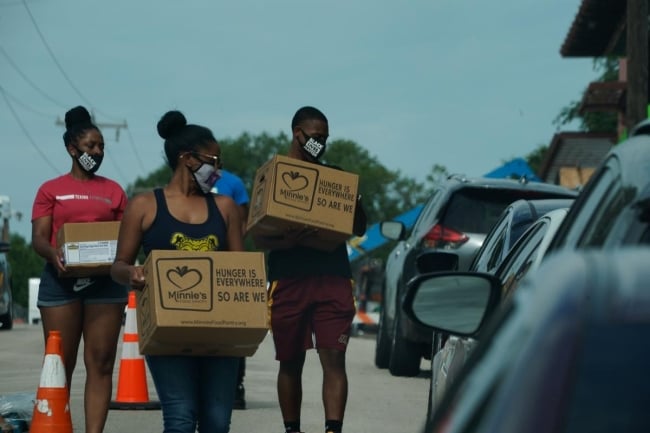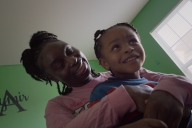You have /5 articles left.
Sign up for a free account or log in.

Bryan R. Smith/Contributor/AFP/Getty Images
Students at historically Black colleges and universities experience high rates of food and housing insecurity, according to a new report released by the Hope Center for College, Community, and Justice. The report is the first from the center specifically focused on the needs of HBCU students and is the driving force behind a new initiative to help 10 HBCUs develop and fund supports for their students.
The center, which is based at Temple University, surveyed nearly 5,000 students from 14 private and public HBCUs in fall 2020 and found that 46 percent of students lacked sufficient food a month prior to when the survey was taken. More than half of the students, 55 percent, said they struggled to maintain safe, affordable housing, and 20 percent said they were homeless in the last year. Certain students, including those who are female, LGBTQ or low income, and those who are parents, wrestled with food and housing insecurity at higher rates than their peers.
“These numbers speak to something far greater than an HBCU problem or an African-American problem,” Michael J. Sorrell, president of Paul Quinn College in Texas, said in the report. “These numbers speak to an American problem. One, which if allowed to go unchecked, will compromise the future of too many talented citizens … What are we as a society doing so wrong that our student class is struggling on such a basic needs level?”
The report, released Thursday, found that COVID-19 had widespread and disruptive economic and mental health effects on HBCU students and their families. More than half of HBCU students knew a friend or family member who had been infected with the virus, and nearly a quarter of students reported that a friend or family member died. Meanwhile, HBCU students lost their jobs at higher rates than students at other kinds of minority-serving institutions and predominantly Black community colleges. About 57 percent of HBCU students working part-time and 40 percent of students working full-time had lost their jobs by fall 2020.
Harry Williams, president and CEO of the Thurgood Marshall College Fund, a membership organization representing public HBCUs, noted that more than 75 percent of HBCU students require federal financial aid to pay for college. He said caring for sick family members and wrestling with economic loss took a mental toll on students who were already struggling financially.
Williams worries these challenges will deter students from staying in college.
“A large percentage of our students come from communities that have been devastated by this dreadful disease,” he said. “If you’re worried about your family members at home … you start the process of questioning, why am I here? And then they have to deal with the mental strain associated with that.”
One “encouraging” finding of the report was that many HBCU students benefited from federal COVID-19 relief funds. More than two-thirds of the students experiencing food and housing insecurity were aware of the emergency aid. Fewer than half of those who knew about the funds applied for emergency grants and 38 percent received grants, though students didn’t necessarily have to apply to receive the support. Many HBCU students put the grant money toward food, transportation and housing, and over two-thirds said the funds helped them afford educational materials, reduce stress and stay enrolled.
Sara Goldrick-Rab, president and founder of the Hope Center, said only some of the HBCU students who applied received the emergency aid because “there is so much need and the money doesn’t go as far,” whereas universities with fewer low-income students in need could afford to distribute more aid to a larger percentage of the student body.
“Only a tiny fraction of students are going to get the help, because everybody has so much need and there’s so many more of them,” she said.
Meanwhile, a fifth of students in need received help from their institutions to apply for the Supplemental Nutrition Assistance Program, or SNAP, which was a higher rate than at minority-serving institutions and predominantly Black community colleges, though few had guidance to find affordable housing. Half of students who didn’t use available campus supports were unaware they existed. Fewer students at HBCUs, however, reported feeling embarrassed to seek out services on campus.
The report found that “there seems to be less stigma associated with seeking out help at HBCUs compared to these other institutions, though stigma still impedes some students from seeking support.”
William Teasley, a senior at North Carolina A&T State University, which was not among the HBCUs in the report, has firsthand knowledge of the hardships of being unable to afford food. Last semester, he worked at the campus food pantry, which the university started two years ago to help students supplement their food supply, and he buys meals through a program he helped establish on campus in 2019 called Swipe Out Hunger. The program allows students to donate unused meal plan points to low-income students.
Teasley also noted that N.C. A&T is “smack-dab in the middle of a food desert,” where the closest grocery store, aside from a Walmart, is two and a half miles away.
“There are a lot of students who I know personally, and even in my own experience, that experience food insecurity on a daily basis,” he said. He sees college administrators increasingly acknowledging the problem and saying in effect that “we’re going to provide you with a great education, however, in order to utilize that education, you’re going to need housing, you’re going to need adequate food, you’re going to need the mental health resources … because if I’m hungry, the last thing I’m worried about is Physics II.”
The report coincided with the launch of a new initiative by the Hope Center, in partnership with the Center for the Study of Historically Black Colleges and Universities at Virginia Union University, to help HBCUs develop more robust supports for students struggling with food, housing and other basic needs problems. Over the course of six months, experts at the center will hold monthly training sessions with student affairs staff members at 10 HBCUs, including six community colleges.
The goal of the initiative, called #RealCollegeHBCU, is to offer guidance on advocating for more state and federal funding for their institutions and building up existing student support services on their campuses. Participants will also have opportunities to swap ideas and share best practices.
Goldrick-Rab said #RealCollegeHBCU is in “response” to the challenges facing HBCU students detailed in the report.
“We aim to facilitate both institutional learning and structural change—including equitable state and federal funding for the sector.”
Atif Qarni, managing director for external affairs at the Hope Center, stressed that HBCUs have historically received less funding than their predominantly white counterparts. To juggle all of the expenses required to run a college or university, HBCUs need sustained state and federal funding, he said.
Qarni, who formerly served as Virginia secretary of education, said in his work with HBCUs, he found “there is much more empathy and awareness about wraparound supports” among HBCU leaders. They understand which resources their students need, but “the only thing that’s really lacking are the dollars.”
He noted that policy makers have increasingly been prioritizing food and housing for students since the onset of the pandemic. For example, the U.S. Department of Education announced Thursday an additional $198 million in COVID-19 relief funding for community colleges and other institutions serving low-income students and issued new guidance on how colleges can use the funds to support students’ basic needs and connect students with federal benefits such as SNAP.
One of the Hope Center’s messages to colleges is, “Look, if you do this work of basic needs based on good, empirical research and you start to improve your systems, it really positions you really well for future funding,” Qarni said. “Because the federal government is starting to pay attention to basic needs, and we’re realizing that state governments are gradually moving there as well.”
The report offers a number of recommendations to policy makers, including increasing funding for the newly established federal Basic Needs for Postsecondary Students Program and making emergency aid permanently available for students, though Qarni said those suggestions are “just the beginning.”
Williams said HBCU students’ inability to afford their basic needs can have nationwide ripple effects. These conditions contribute to debt and low retention and graduation rates among Black students, which “slows you down to buy your first home” and to “start building wealth,” contributing to a persistent racial wealth gap.
However, he also noted that sustained state, federal and philanthropic investments in HBCUs—which have increased since the murder of George Floyd in 2020—can have long-term, positive implications for the economy, by providing students with an education that prepares them for the workforce.
“The most important [thing] from my perspective is the structural and institutional investments into the student support services areas for our campuses that’s going to allow for our students to stay in school and persist towards graduation,” he said.









